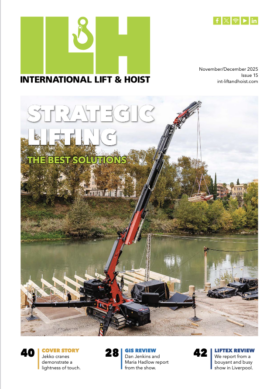Liebherr Consigns Economic Crisis to “the Past”
Liebherr-Werk Nenzing GmbH, the German company's mobile harbor crane department, has consigned the economic crisis to 'the past' in a statement issued this week. “Increasing positive signs from the industry give reason to believe the economic crisis is part of the past,” it said. Again, globalization, worldwide integration of markets and liberalization of global trade result in rising movement of goods. Furthermore the trend for bigger and bigger vessels is still existent, it added. As the cargo handling industry is evolving, so is the need for efficient, cost-effective cargo handling equipment.
In addition, no manufacturer these days can reject the demand for sustainable, environmentally sensitive operation and the call for low-emission cargo handling equipment.
In 2009 the world market for mobile harbor cranes developed noticeably weaker (-40 percent) than in the previous year as a result of declining demand following the international financial and economic crisis. With a 30 percent decline in order intake, Liebherr withstood the difficult market conditions in 2009 compared to the total market.
In the course of the reporting year a stable development could be recorded. Order intake developed analogously to the still difficult, but promising market environment. At the end of 2010 turnover reached $283 million (€210 million), a slightly higher figure than in 2009.
With regards to regional distribution of turnover Europe accounted for 38 percent, Latin America for 18 percent, India for 15 percent and Africa for 12 percent. The rest is more or less equally shared by North America, the Middle East, Far East Asia and Australia.
Liebherr said 2010 was all about mastering challenges and securing the future. It called the introduction of the Pactronic hybrid drive system “a quantum leap,” which is already reflected in the figures of the order backlog. As of 31 December, the order backlog for Liebherr mobile harbor cranes amounted to more than $135 million (€100 million). Of the existing orders, the new LHM 550 incl. Pactronic accounted for more than 25 percent.
Products
It highlighted its Liebherr Pactronic, which was introduced to the market in 2010, as an innovative market leader. This new hybrid drive addresses two critical issues: reducing fuel/power consumption; and increasing handling performance.
In the past, improved handling performance of a crane was accomplished by increasing the primary energy source (diesel/electric engine), which on the one hand is a very expensive solution and on the other hand leads to an increased fuel/energy consumption.
Now with the new hybrid drive the power enhancement is done by adding an additional energy source to the drive system; in this case a hydraulic accumulator. Charging of the accumulator is done by regenerating the reverse power while lowering the load. The stored energy of the accumulator is then transferred back to the system when the crane requires peak power during hoisting.
This energy storage technology provides decisive advantages compared to storage technology based on batteries or capacitors. The accumulator of the Pactronic drive system is designed for a lifetime equal to the crane and just needs visible inspection every 10 years. The Liebherr Pactronic hybrid drive is an integrated approach, which means there are no additional running costs.
Unbeatable charge and discharge times are combined with extreme robustness, which means no additional cooling, conditioning or isolation is needed. In addition, it is 100 percent recyclable as the system consists of steel, nitrogen and hydraulic oil only. A hybrid drive system with the same performance based on batteries or capacitors has a realistic life time of 4-5 years and produces tons of hazardous waste within every service life.
The whole system is based on the fact that hybrid drives are perfectly suitable for mobile harbor cranes, because these machines are designed for constant turnover and their movements are characterised by alternating load cycles during operation. Hoisting needs a lot of energy and during lowering this energy can be recovered.
With Pactronic turnover capacity (ton/hour) is increased by 30 percent compared to a conventional machine with equal power rating of the primary energy source. To that effect customers benefit from reduced terminal costs and higher productivity. Furthermore long docking times and high demurrage rates are reduced substantially.
In addition, compared to the conventional diesel/electric engine, the combined hybrid drive leads to a reduction of fuel/energy consumption (gallon/ton) as well as emissions in the range of 30 percent depending on the operation. But again, increased handling performance is the main difference to conventional hybrid drive systems and is directly linked to a reduction of total cost of ownership at the end of the day.
Pactronic was introduced to the market on the new LHM 550. Serial production started in October 2010. So far there are already more than 10 machines on order.
Last year also saw the launch of the LHM 550, a new model providing the customer with the same modular construction system available on the LHM 600. Different applications call for different configurations of winches and drive systems to conform to all variants of professional cargo handling. Tower extension and boom variants with different radii complement the modular concept.
For dedicated container handling the recommended crane set-up goes with a 177 feet (54 meter) boom; 38 tons (34.5 tonnes) at maximum outreach (177 feet) allow for container handling up to the 18 row of a post-panamax container liner. With Pactronic the LHM 550 achieves up to 38 moves per hour.
For dedicated bulk handling the recommended crane set-up goes with a 48 meter boom. This configuration of 48 tons (43.5 tonnes) at 131 feet (40 meters) is perfectly suited to handle capsize bulk carrier. With Pactronic the LHM 550 achieves up to 2205 tons (2000 tonnes) per hour.
The LHM 550 is the first model available with the Pactronic hybrid drive, which will be gradually rolled out on all crane models and by 2013 the system will be offered on Liebherr’s entire mobile harbor crane range.
The Liebherr Group comprises more than 100 companies worldwide and employs a total workforce in excess of 32,000 people. In 2009, Liebherr achieved a total consolidated turnover of about $9.1 billion (€6.8 billion). Liebherr-Werk Nenzing GmbH, Nenzing (Austria), is the largest maritime crane production site and head of the divisional controlling company, the Liebherr-MCCtec GmbH, which is responsible for the Liebherr range of maritime cranes.











